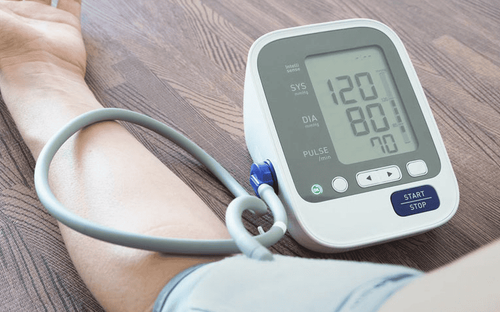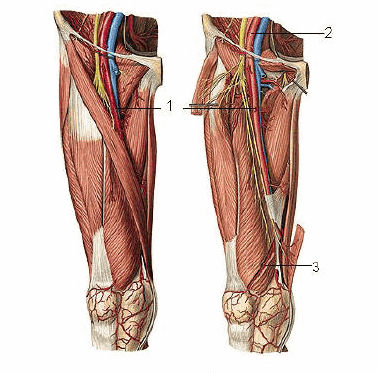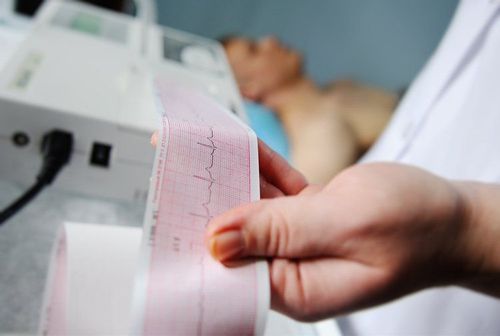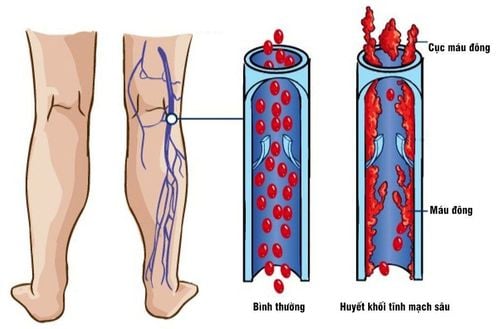This is an automatically translated article.
The article was professionally consulted by Specialist Doctor I Nguyen Truong Duc - Radiographer - Department of Diagnostic Imaging and Nuclear Medicine - Vinmec Times City International General Hospital. Dr. Duc has more than 17 years of experience in diagnostic imaging.Pulmonary embolism is a disease that requires rapid diagnosis and treatment to limit the risk of death. To confirm the diagnosis, besides clinical judgment, supporting tests such as ultrasound, X-ray, CT, lung scan also play a particularly important role.
1. What is a pulmonary embolism?
Blood clotting is the cause of the formation of blood clots that cause pulmonary embolism. In essence, blood clotting is a form of protection for the body from losing a lot of blood when injured. However, in some cases, abnormal clotting of blood vessels has occurred, most commonly deep vein thrombosis. When a blood clot breaks off and moves freely through a blood vessel, it has the potential to cause a blood vessel occlusion.Pulmonary embolism occurs when a blood clot ruptures, travels through the blood vessel, and becomes trapped in the small blood vessels in the lungs. In addition to blood, a number of other substances are also capable of causing pulmonary embolism such as fat, collagen, other types of tissue and air bubbles.
Pulmonary embolism can be life-threatening and cause irreversible damage to the lungs. The severity depends on the size of the occluded vessel and the number of occluded vessels, and the patient's baseline cardiac and pulmonary function.
About half of patients with pulmonary embolism have no symptoms. Symptoms of pulmonary embolism occurred in the remaining subjects with the following manifestations:
Shortness of breath or shortness of breath Chest pain, especially sharp pain when breathing deeply Coughing or coughing up blood Swelling, pain or cyanosis of the legs Heart rate is not steady or rapid and/or strong Dizziness and lightheadedness Certain illnesses and treatments increase the risk of blood clots and pulmonary embolism including:
Cancer Personal or family history of blood clots vein or pulmonary embolism Cardiovascular disease Hip fracture, leg fracture, or other trauma Surgery Inactivity due to surgery, trauma, bed rest, prolonged sitting (long periods of time in a car or plane) or numbness paralysis Smoking Certain medications such as birth control pills , hormone replacement therapy or Tamoxifen Pregnant and lactating women Advanced age Obesity .
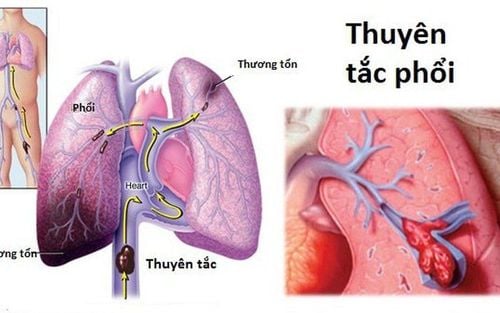
Thuyên tắc phổi xảy ra khi cục máu đông bị vỡ, di chuyển trong lòng mạch và bị kẹt lại ở các mạch máu nhỏ ở phổi
2. How to diagnose pulmonary embolism?
In addition to taking medical history, asking about disease and performing other clinical evaluation tests. The patient is also asked to perform the following tests to diagnose a pulmonary embolism:Blood tests Chest X-ray Electrocardiogram Venous ultrasound: An ultrasound of the veins uses sound waves to help blood vessels be displayed on the blood vessels. computer screen to look for blood clots. In the diagnosis of pulmonary embolism, the patient underwent Doppler ultrasound. This is a special technique for observing and evaluating blood flow through arteries and veins. If the ultrasound does not find a clot, other imaging techniques will be added. CT pulmonary angiogram: A CT angiogram uses X-rays and an iodine-containing contrast agent to create images of the chest that highlight the blood vessels in the chest and lungs. V/Q lung scan: A V/Q lung scan uses a small amount of radioactive material and a special camera to look at the flow of blood and air in the lungs.
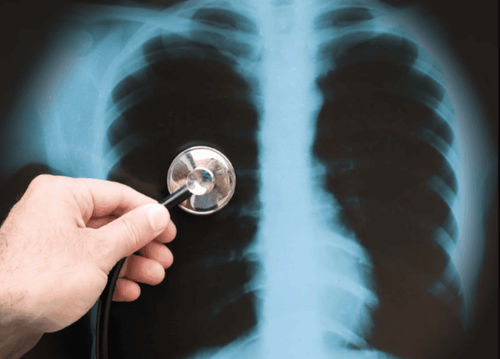
X-quang ngực chẩn đoán thuyên tắc phổi
3. How to treat pulmonary embolism?
Treatments for pulmonary embolism mainly focus on stopping blood clots from growing in size, preventing clots from traveling to the lungs, and preventing new blood clots from forming.Anticoagulants: Anticoagulants help prevent blood clots from increasing in size and forming new clots. This is the main method used in the treatment of pulmonary embolism and deep vein thrombosis. However, the drug increases the risk of bleeding, so it is contraindicated in some subjects. Placement of inferior vena cava filter: The IVC filter is a small metal device that is placed in the inferior vena cava or IVC. The filter helps prevent large blood clots or clots from the lower half of the body from traveling to the heart and lungs. This procedure is used in patients who do not respond to or have contraindications to anticoagulation. Thrombolytics: Thrombolytics are used to dissolve or break up blood clots that are causing serious symptoms and complications in the body. This drug is usually used only in life-threatening situations. Central venous catheters: Central venous catheters remove or dissolve abnormal blood clots in blood vessels to improve blood flow and prevent damage to organ tissues. After the catheter is inserted into a blood vessel through an incision in the skin and reaches the site of the blockage, medication or a mechanical device is inserted through the tube to break up or remove the clot. This is only done in patients with serious complications related to pulmonary embolism. Pulmonary embolism is a dangerous condition and can leave many complications. Therefore, it is necessary to accurately diagnose the condition of the disease so that the doctor can direct the examination and timely treatment.

Thuốc chống đông máu được sử dụng trong điều trị thuyên tắc phổi và huyết khối tĩnh mạch sâu
After having an accurate diagnosis of the disease and stage, the patient will be consulted to choose the most appropriate and effective treatment methods. The treatment process is always closely coordinated with many specialties to bring the highest efficiency and comfort to the patient. After undergoing the treatment phase, the patient will also be monitored and re-examined to determine whether the treatment is effective or not.
Please dial HOTLINE for more information or register for an appointment HERE. Download MyVinmec app to make appointments faster and to manage your bookings easily.
Reference source: adiologyinfo.org




